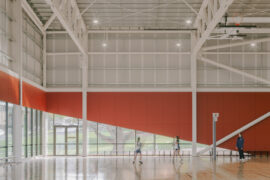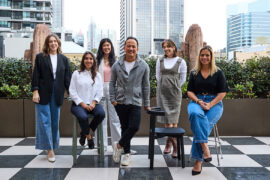As students assimilate to new look ‘ambient’ learning spaces, teachers are left in limbo. Have our system innovations hacked out the educators? Fiona Young of Hayball shares insights into the shifts in the education sector.
In the past few years, architects and designers have successfully applied the ‘IKEA hack’ concept to education spaces, with the resulting innovative learning environment (ILE) providing an outcome as exciting as it is ingenious. Indeed, disrupting traditional learning environments with new ways of thinking about education is necessary if progress is to take place.
While even more disruptive thinking needs to occur, current pedagogies keep reinforcing the need for the development of other skills beyond literacy and numeracy. Increasingly, the emphasis is being placed on socially negotiated processes of study that encourage collaboration, communication and creativity, making it imperative that all new spatial designs support and enable these flexible, agile activities.
Within primary and secondary schools this new ILE is, in many ways, a complete antithesis of the old classroom. There has been a shift away from having just one focal point to having multiple ones, and the overall ambience is much more relaxed, to make students feel as comfortable as possible in their learning experience.
Rather than cellular, the new floor plan is open and generously proportioned to accommodate a diverse range of settings. These settings comprise fixed and loose furniture, suitable for both autonomous and group work. Students can now choose how they study, allowing them to take ownership of their learning, which breeds a culture of empowerment.
This is being evidenced in recently completed projects such as The Learning Project at Caulfield Grammar School in Melbourne. Designed by Hayball, it’s a particularly good example of an ILE that’s pushing the boundaries, because not only does it function as a vehicle for change by exploring new ways of learning, it’s also being used to up-skill teachers.
Hayball’s Sydney studio co-director, Fiona Young, is committed to the re-imagining of education spaces and as a member of the University of Melbourne’s Learning Environments Applied Research Network (LEARN) she’s at the forefront of new thinking around the design of ILEs.
Young understands better than most this pressing need for teacher re-education. “It’s a very big ask to throw teachers into an innovative learning environment and expect them to know how to use it,” she says. “Especially when most of them were probably trained in a more cellular type space.”
Young and her LEARN colleagues currently spearhead the Innovative Learning Environments and Teacher Change (ILETC) project, an Australian Research Council Linkage Project funded for four years up until 2019. “One of the ILETC’s core goals is to develop strategies and tools to help teachers transition to new learning environments,” explains Young.
Developing prototype spaces (not dissimilar to The Learning Project model) that assist teachers in changing their approach to new technologies and ILEs, as well as investigating the mechanisms required to shift teacher mind frames, supports this research.
Architects and designers can certainly deliver new spatial designs to enable current pedagogies, but there’s no point if no one knows how to use them. Good infrastructure is one thing. Getting the best out of it, is another. Ensuring this happens calls for a holistic design approach that’s uncompromisingly humancentric, where all stakeholders are given opportunities to input, learn and better understand the potential of these new learning environments.
However, Young believes the greatest disruption needed to bring about more dynamic education spaces is a change in people’s fundamental conceptions. As she explains: “There are a lot of different ways to think about a school and we also have to start thinking about creating lifelong learning opportunities.”
Future typologies could see schools sharing commercial tenancies, being embedded within a cultural institution or included as part of new residential developments. The emphasis is on greater community connection; a challenging yet exciting prospect made all the more potent by the promise of an enriched student learning experience.
This article originally appeared in issue #73 of Indesign, the ‘Information Age’ issue.
–
Get all the latest from Australia’s design industry straight to your inbox, sign up for our newsletter.
INDESIGN is on instagram
Follow @indesignlive
A searchable and comprehensive guide for specifying leading products and their suppliers
Keep up to date with the latest and greatest from our industry BFF's!

It’s widely accepted that nature – the original, most accomplished design blueprint – cannot be improved upon. But the exclusive Crypton Leather range proves that it can undoubtedly be enhanced, augmented and extended, signalling a new era of limitless organic materiality.

Joan Montgomery Centre PLC by Warren and Mahoney is a tour de force of education design, with high-end facilities including a swimming pool and general athletic amenities.

A new STEAM project by Life Architecture and Urban Design for St Columba’s College, in Essendon, Victoria is education design at its best.
The internet never sleeps! Here's the stuff you might have missed

To mark a full year of Bradhly Le’s young studio, the team at RIZEN Atelier share their impressions and inspirations so far.

Architectus Principals Simone Oliver and Patricia Bondin are set to speak at WORKTECH Sydney this year, so we asked them for some sneaky early insights on workplace design.